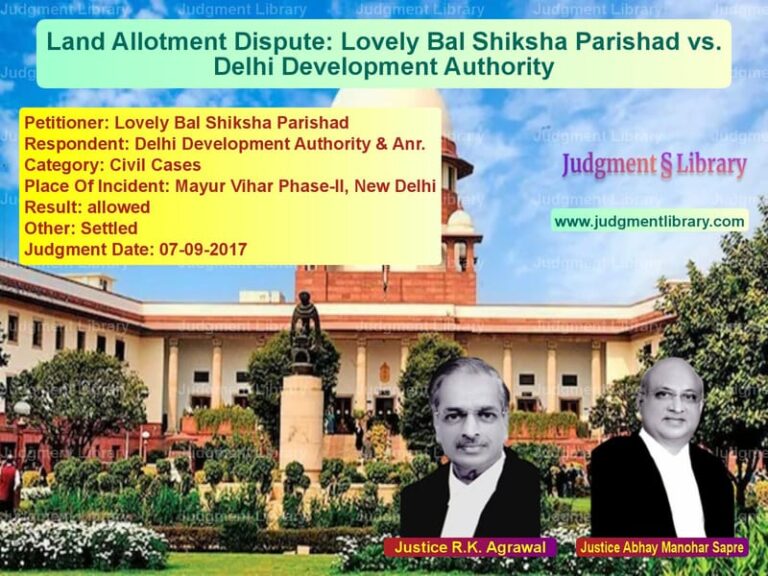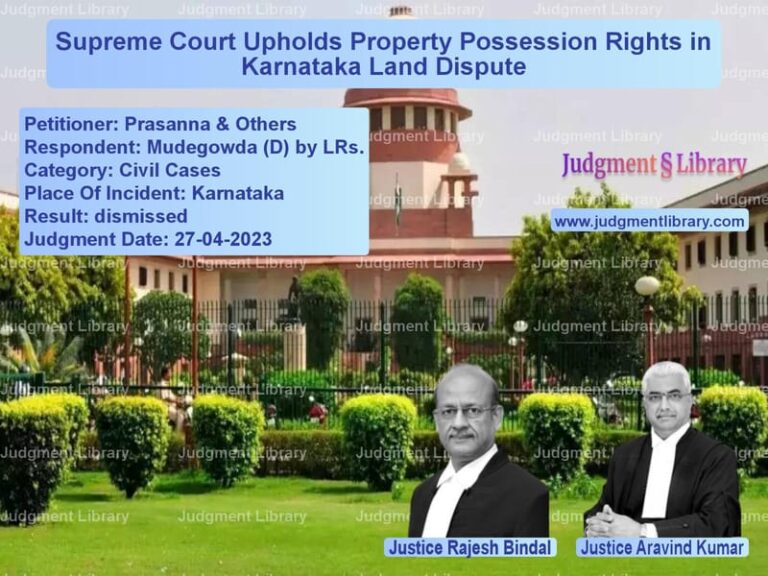Supreme Court Modifies Conviction in Chhattisgarh Attempt to Murder Case: Key Legal Takeaways
The Supreme Court of India, in its judgment dated April 11, 2023, in Panchram vs. State of Chhattisgarh & Anr., modified the conviction of the appellant from Section 307 IPC (Attempt to Murder) to Section 326 IPC (Voluntarily Causing Grievous Hurt by Dangerous Weapons). The Court reduced the sentence to the period already undergone, considering the long delay and circumstances surrounding the case. This ruling highlights the importance of intent, nature of the weapon used, and the severity of injuries in determining appropriate sentencing under criminal law.
Background of the Case
The case stemmed from an altercation that took place on May 4, 1999, in a village in Chhattisgarh. The prosecution alleged that the accused, Panchram, attacked the complainant, Salikram, using a pair of tailoring scissors. The assault caused injuries to Salikram’s abdomen and left thigh. The alleged motive behind the attack was a personal dispute arising from suspicions of an illicit relationship between the complainant and the accused’s wife.
Following the incident, the police arrested Panchram and charged him under multiple sections of the Indian Penal Code (IPC), including:
- Section 307 IPC – Attempt to Murder
- Section 341 IPC – Wrongful Restraint
- Section 506 IPC – Criminal Intimidation
Trial Court Proceedings
The trial court convicted Panchram under the above sections and sentenced him as follows:
- Five years of rigorous imprisonment and a fine of ₹1,500 under Section 307 IPC.
- One month of rigorous imprisonment under Section 341 IPC.
- Six months of rigorous imprisonment under Section 506 IPC.
The prosecution primarily relied on witness testimonies, medical reports, and the alleged recovery of a blood-stained pair of scissors from the accused.
High Court’s Ruling
Panchram appealed to the Chhattisgarh High Court, arguing that the trial court erred in convicting him under Section 307 IPC. However, the High Court dismissed his appeal on October 11, 2018, upholding the trial court’s verdict. The High Court reasoned that:
- The injuries inflicted were serious, particularly since one of them was in the abdominal area.
- The accused intended to kill the complainant, as evidenced by the targeted nature of the attack.
- Scissors, though not a conventional weapon, can cause fatal injuries if used with intent to kill.
Arguments by the Appellant
Before the Supreme Court, the appellant’s counsel contended:
- The fight was sudden and not premeditated.
- The injuries were not life-threatening and did not justify a conviction under Section 307 IPC.
- The weapon used was a small pair of scissors, which is not commonly used for homicide.
- The complainant himself admitted in cross-examination that there was a long-standing personal dispute.
- A compromise deed was reached between the parties on April 30, 2019, showing no lingering animosity.
Arguments by the State
The prosecution opposed the appeal, arguing:
- The accused intended to kill the complainant by targeting vital body parts.
- Even if the weapon was small, it was sharp and used in a manner capable of causing fatal injuries.
- The conviction under Section 307 IPC was justified given the severity of the attack.
Supreme Court’s Observations
The Supreme Court, comprising Justices Abhay S. Oka and Rajesh Bindal, examined the evidence and made key observations:
- “The fight was not pre-planned but a result of a sudden altercation.”
- “The weapon used was small scissors, which is not classified as a dangerous weapon under the IPC.”
- “The injuries were grievous but not life-threatening.”
- “The complainant admitted in cross-examination that the dispute arose from personal matters, not a planned attack.”
- “Most prosecution witnesses, including Rajkumar (PW-6) and Radhey Shyam (PW-7), turned hostile and did not fully support the prosecution’s case.”
Final Judgment
The Supreme Court modified the conviction and sentence as follows:
- Conviction under Section 307 IPC was reduced to Section 326 IPC (Causing Grievous Hurt by Dangerous Weapons).
- Sentence reduced to time already served (11 months, 24 days).
- The fine of ₹1,500 was maintained.
Implications of the Judgment
This ruling has significant implications for criminal law:
- Intent vs. Injury: Courts must differentiate between an attempt to murder and an act that merely causes grievous hurt.
- Nature of Weapon Used: The Supreme Court clarified that using a pair of scissors, though sharp, does not necessarily indicate murderous intent.
- Judicial Discretion: The Court took a pragmatic approach considering the long pendency of the case and the compromise between the parties.
Conclusion
The Supreme Court’s ruling in Panchram vs. State of Chhattisgarh highlights the nuanced approach needed in criminal cases where evidence is circumstantial, and intent is questionable. By modifying the conviction and sentence, the Court ensured that the punishment was proportionate to the crime while upholding the principles of justice.
Petitioner Name: Panchram.Respondent Name: State of Chhattisgarh & Anr..Judgment By: Justice Abhay S. Oka, Justice Rajesh Bindal.Place Of Incident: Chhattisgarh.Judgment Date: 11-04-2023.
Don’t miss out on the full details! Download the complete judgment in PDF format below and gain valuable insights instantly!
Download Judgment: panchram-vs-state-of-chhattisgar-supreme-court-of-india-judgment-dated-11-04-2023.pdf
Directly Download Judgment: Directly download this Judgment
See all petitions in Bail and Anticipatory Bail
See all petitions in Attempt to Murder Cases
See all petitions in Judgment by Abhay S. Oka
See all petitions in Judgment by Rajesh Bindal
See all petitions in partially allowed
See all petitions in Modified
See all petitions in supreme court of India judgments April 2023
See all petitions in 2023 judgments
See all posts in Criminal Cases Category
See all allowed petitions in Criminal Cases Category
See all Dismissed petitions in Criminal Cases Category
See all partially allowed petitions in Criminal Cases Category







